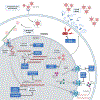Emerging antiviral therapeutics for human adenovirus infection: Recent developments and novel strategies
- PMID: 33577808
- PMCID: PMC7965347
- DOI: 10.1016/j.antiviral.2021.105034
Emerging antiviral therapeutics for human adenovirus infection: Recent developments and novel strategies
Abstract
Human adenoviruses (HAdV) are ubiquitous human pathogens that cause a significant burden of respiratory, ocular, and gastrointestinal illnesses. Although HAdV infections are generally self-limiting, pediatric and immunocompromised individuals are at particular risk for developing severe disease. Currently, no approved antiviral therapies specific to HAdV exist. Recent outbreaks underscore the need for effective antiviral agents to treat life-threatening infections. In this review we will focus on recent developments in search of potential therapeutic agents for controlling HAdV infections, with a focus on those targeting post-entry stages of the virus replicative cycle.
Keywords: Adenovirus; Antiviral; Cidofovir; Drug repurposing; Drug synergy; Host-pathogen interactions; Outbreak; Synthetic-lethal.
Copyright © 2021 Elsevier B.V. All rights reserved.
Conflict of interest statement
Declaration of interests
The authors declare that they have no known competing financial interests or personal relationships that could have appeared to influence the work reported in this paper.
Figures

References
-
- Abraham AA, John TD, Keller MD, Cruz CRY, Salem B, Roesch L, Liu H, Hoq F, Grilley BJ, Gee AP, Dave H, Jacobsohn DA, Krance RA, Shpall EJ, Martinez CA, Hanley PJ, Bollard CM, 2019. Safety and feasibility of virus-specific T cells derived from umbilical cord blood in cord blood transplant recipients. Blood Adv. 3, 2057–2068. 10.1182/bloodadvances.2019000201 - DOI - PMC - PubMed
-
- Aguilar-Guisado M, Marrugal-Lorenzo JA, Berastegui-Cabrera J, Merino L, Pachón J, Sánchez-Céspedes J, 2020. In vitro co-infection by cytomegalovirus improves the antiviral activity of ganciclovir against human adenovirus. Int. J. Antimicrob. Agents 56, 106046. 10.1016/j.ijantimicag.2020.106046 - DOI - PubMed
-
- Andersson EK, Strand M, Edlund K, Lindman K, Enquist P-A, Spjut S, Allard A, Elofsson M, Mei Y-F, Wadell G, 2010. Small-Molecule Screening Using a Whole-Cell Viral Replication Reporter Gene Assay Identifies 2-{[2-(Benzoylamino)Benzoyl]Amino}-Benzoic Acid as a Novel Antiadenoviral Compound. Antimicrob. Agents Chemother 54, 3871–3877. 10.1128/AAC.00203-10 - DOI - PMC - PubMed
Publication types
MeSH terms
Substances
Grants and funding
LinkOut - more resources
Full Text Sources
Other Literature Sources

